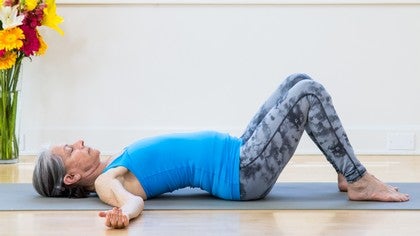Description
About This Video
Transcript
Read Full Transcript
Hi, welcome. I'm going to show you a diaphragm stretch and it's done on the floor in pelvic tilting on the back and it's an excellent way to start to feel the movement of the organs going down and the release and drawing, pushing of the organs back up. And it's very, very helpful kind of thing to do before stretching the outer body, could happen after the outer body, but it goes with wanting, being able to open for pranayama. So I'm going to come onto my back and talk you through it, but the first time it might be very helpful if you just watch because it's a very visual kind of thing that you'll get more fully if you see it rather than just listening this time. So here goes, I'm going to come onto my back. And in pelvic tilting you can see that there's a pretty good arch to the back and then the reverse tilt flattens the back into the ground. And I'm using my feet pushing in this direction using the psoas. So that's the physical movement. The breath work involves inhaling and pushing down with the diaphragm so that the belly actually is exaggeratedly full and then drawing up. So exhale, you press firmly back, which pushes the organs up towards your lungs. Inhale, tilting, pushing the belly down. Exhale, pressing back, drawing the organs up. The abdomen presses down to make this happen. So when we do this as a diaphragm stretch, that's a good stretch on its own, I'm going to have you hold your breath in. So you've just breathed in to get to this position and then you're going to pause the breath and tilt back and forth a couple of times. Maybe even three. And then the second round you'll be breathing out and doing the same activity and you'll really get more of the feeling not only of pushing the organs down but also drawing them up. And why we don't just do this one is because when your breath is in and you're full and you do that activity, you're pushing against a certain amount of pressure which actually helps things to start to open up. So here's the second one. Exhale. Inhale, pushing down. Exhale, pressing the abdomen back firmly. Inhale, pushing down. You're using your diaphragm to do that. This third one, when I exhale, I'm going to hold the breath in and do it. So, I think you could see that I didn't let the breath go suddenly. That wasn't holding the breath in, that was holding the breath out. All right, so I'm going to lie back down and I will be doing it but I'll be talking you through it. Okay, you're on your back. Knees bent, comfortable distance away from the pelvis. And just begin the pelvic tilting.
Press with your feet. Your chin may come up. Don't worry about it. Back is flat. Tilt in the opposite direction. So the back arches. Press your lower back down. Okay, now you add the breathing as you breathe in and tilt. Push your belly down and out and don't worry. It's a big fat belly and that's what it's supposed to be. Press the abdomen back. The organs go up. Inhale. Press down. The organs are down. Exhale. Press back with the abdomen. The organs go up. Next inhale. Pause your breath in. Tilt backward. Still, even though the breath is in, you're pressing the abdomen back. Press down again with the belly full. Do a tilt. Press down with the abdomen so that your organs go up into your chest. Pause here. Start relaxing your tilt and slowly let the breath out. You don't want it to rush out and just pause a moment breathing whatever kind of breath your body wants right now. There's a little recovery time, maybe about three breaths. Keep your eyes just gently down towards the center of your body. And then you'll do it again, this time the same thing. Inhaling. Pushing the belly down. Exhaling. Pressing the belly back. Inhale. Push down with the diaphragm. Make the belly fat. Exhale. Press back. One more like that. Inhale. Make fat belly arched back. Exhale. Back flat. Lower belly flat. Pause your breath on the out and then push the organs down again using the diaphragm and draw the organs up as you tilt back. Still holding the breath. Push the belly down. Tilting into an arch. Tilt flat back. And pause there. You can feel the uplift and the wonderful internal stretches that happen with this stretch. It's called udiyana bandha. And then start coming out of your tilt and slowly let the breath come back in again. And again, recovery breath takes about three, just. If you're sort of thirsty for breath, be thirsty. Take it in.
And you'll notice over a cycle of maybe three or four breaths, each breath gets a little calmer and a little easier. And then you can roll over onto your right side and it's going to have you come to sitting so that you can feel it, the after effect. So there's one thing, the sensation of the physicality of it all. And then there's the after effect. And you can either close your eyes or just let your eyes be soft, slightly downturned. Notice what your breathing is like. You feel a little more ease in the belly. You may feel more calm, more centered. Notice what you feel because if it turns out that maybe that was a little too strong a practice for you, you need to acknowledge that to yourself. It might not be the practice for you. I've done this with many, many of my students and they love it. It seems to release a lot of space around inside and outside the middle of the torso. So just quietly sitting with it for about 30 more seconds. Good. And then we'll see you in the next session.
Namaste.
Pranayama & Meditation: Patricia Sullivan
Comments
You need to be a subscriber to post a comment.
Please Log In or Create an Account to start your free trial.













